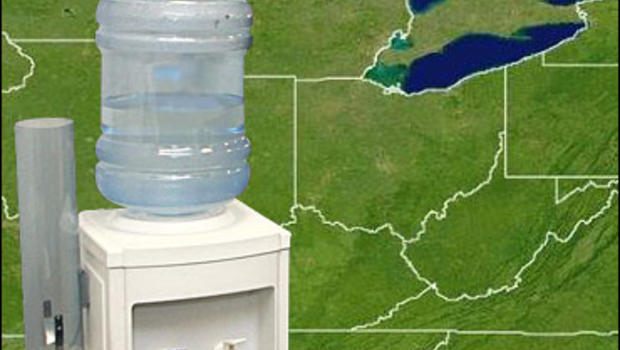DuPont facing key judgment over Teflon chemical in Ohio River

The reflection of the West End Bridge glimmers on the water and thawing ice as a towboat pushes a platform up the Ohio River in Pittsburgh, Thursday, Jan. 14, 2010.
AP Photo/Keith Srakocic
JULY 5, 2016
COLUMBUS, Ohio - Jurors in an Ohio federal court are poised to decide whether DuPont's C8 chemical caused a man to get cancer and - if so - whether it acted in "conscious disregard" by dumping it from its plant in West Virginia into the Ohio River.
The Columbus Dispatch reports testimony in the Columbus courtroom concluded last week in the case against the Delaware-based chemical company. Jurors are expected to begin deliberations on Tuesday.
There are 3,500 lawsuits alleging a link between illnesses and the company's discharging of the chemical into the river.
In this case, David Freeman, of Washington County, says he got testicular cancer because of C8, which was used to make Teflon.
Freeman, 56, says in his lawsuit that residents along the river suffered from C8 in tainted drinking water, which he blamed for his sickness.
DuPont maintains there were only small the amounts of C8 in drinking water - not enough to be harmful.
Dawn Jackson, a former spokeswoman for DuPont's Ohio River plant in Parkersburg, West Virginia, has testified she never knew of any concerns about C8 being dumped into the river when she told residents the water was safe to drink.
An attorney for Freeman showed Jackson internal company documents and memos about concerns with C8, many of which she said she had never seen before.
Freeman's case is among the first few cases to be heard. In one now under appeal, jurors awarded $1.6 million to a woman who got cancer.
The C8 chemical is also known as Perfluorooctanoic acid (PFOA,) and it has been used for decades in the production of a wide range of everyday products. It is mainly used in the manufacture of nonstick cookware.
The route of human exposure is not well understood, but recent studies suggest that just about everyone has some PFOA in the blood. Identified sources of exposure include drinking water, food packaging, microwave popcorn, and even air. Cookware containing Teflon, made by DuPont, and similar nonstick surfaces are made using PFOA. But the cookware industry has long maintained that cooking in nonstick pots and pans is not a significant source of exposure to the chemical, and the science appears to back up the claim.
© 2016 CBS Interactive Inc. All Rights Reserved. This material may not be published, broadcast, rewritten, or redistributed. The Associated Press contributed to this report.
========================================
Teflon Chemical Found In Spring Water

Spring water graphic against map of Ohio and West Virginia, for story about DuPont providing bottled water to customers in one of the six districts in Ohio and West Virginia where the drinking water contains C8, a chemical used to make Teflon, a DuPont product. (CBS/AP)
CBS/AP
Bottled water provided to southeast Ohioans whose tap water contained a chemical used to make Teflon has tested positive for the same chemical, according to several tests.
DuPont hired three companies to provide bottled water to customers in one of the six districts in Ohio and West Virginia where drinking water contains C8.
The bottled water will be provided until filters are installed at the Little Hocking Water Association, in Washington County, Ohio. Tests have shown that customers in that district had 80 times more C8 in the blood than the general population.
More than 1,000 residents in the district received bottled water from Marietta-based Crystal Spring Water.
When Little Hocking officials decided to test the bottled water to assess the accuracy of C8 testing methods, they found traces of the chemical in the Crystal Spring bottles.
Crystal Spring owner Gary Matheny said he conducted two tests after hearing of the results and found C8 as well.
Matheny said the company has started giving residents treated water and is installing a filter to remove C8 from the spring water the company uses.
"We've been using that well for 84 years and we'e never had a problem with it until now," Matheny told The Marietta Times, adding that the filter should be in place by the end of next week. "We don't know how it got there — at levels this low it may be something as simple as Teflon tape on a fitting — but we are exploring every avenue and we are taking the necessary steps to remove it."
The bottled water showed C8 levels at 13 to 17 parts per trillion. The well supply that provides the residents' tap water contained 3,500 parts per trillion to 7,200 parts per trillion.
The Marietta Times, on its website, says the chemical has never been regulated by the federal Environmental Protection Agency, but an interim "safe" level recognized by Ohio and West Virginia environmental officials is 150 parts per billion.
DuPont, which says C8 poses no human health threat, has agreed to update its plants as part of a settlement of a 2001 class-action lawsuit. Residents claimed the chemical, released from the company's plant near Parkersburg, W.Va., contaminated drinking water.
DuPont also is funding a health screening and study for up to 80,000 residents who receive their drinking water from the six districts.
© 2006 CBS Interactive Inc. All Rights Reserved. This material may not be published, broadcast, rewritten, or redistributed. The Associated Press contributed to this report.